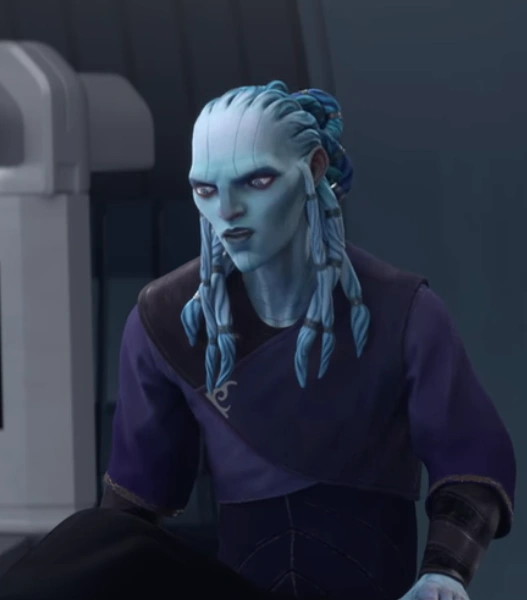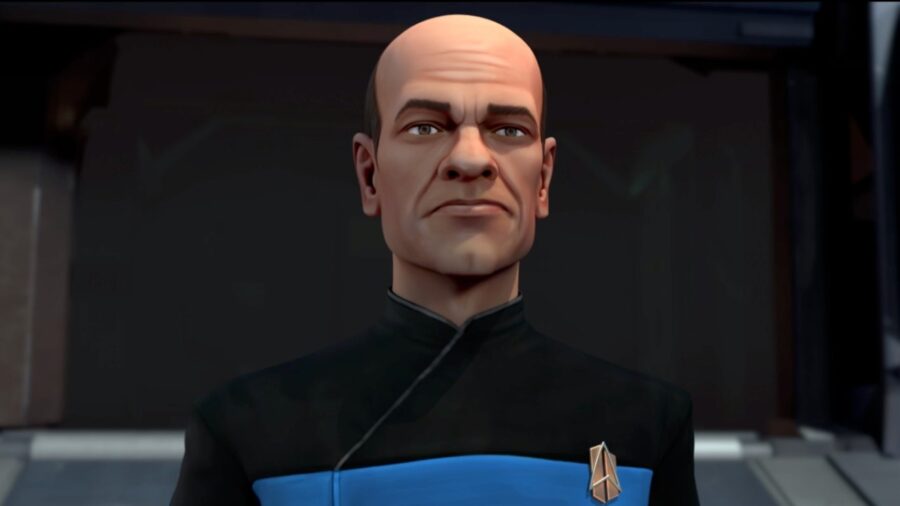The title refers to the transdimensional fissures that Cerritos has been dealing with in this season.
Raktajino is “Klingon Coffee”, although in truth its history is a bit more complicated. In short, raktajino is a Federation version of ra’taj (Klingon coffee with liquor) with added nutlike flavoring (making it raktaj) and cream, creating a portmanteau of “raktaj” and “cappuccino”: raktajino. A fuller explanation can be found here. As a side note, the Klingons got coffee from raiding human ships, and both developed a taste for it and started growing it themselves on Qo’noS.
Mariner and Boimler are drinking from Highwave Hotjo 14 oz. travel mugs, which were used as props on DS9. Boimler’s full beard has finally grown in, mutton chops and all.
Boimler was transporter cloned by accident in LD: “Kayshon, His Eyes Open”, with the clone taking the name William Boimler, taking Bradward’s place on the USS Titan. William was apparently killed by a neurocine gas leak in LD: “Crisis Point 2: Paradoxus”, but that was a cover for his recruitment by Section 31.
Oddly enough, Section 31 - the rogue covert intelligence organization that does (officially) unsanctioned ops in the name of preserving the Federation, first mentioned in DS9: “Inquisition - is never mentioned in the episode. However, William is wearing a Section 31 combadge (first seen in DIS: “Point of Light”).
Shax died in LD: “No Small Parts”, but reappeared with only vague allusions to dark truths about scientific depravity and the afterlife in LD: “We’ll Always Have Tom Paris”.
William’s command, the Defiant-class USS Anaximander, escapes Quantum Reality 582.76-Φ. With him are alternate universe counterparts of characters we know. Anaximander (c.610 to c.546 BC) was a Greek philosopher, a student of Thales, who subscribed to the notion the the universe arose from a boundless ultimate reality, the apeiron.
The Anaximander name was given to a Ptolemy-class transport tug (NCC-3804) in Franz Joseph’s 1975 Star Fleet Technical Manual.
In our reality, T’Pol (voiced by original actor Jolene Blalock) was Archer’s first officer on the NX-01 Enterprise, from ENT, who had a relationship with Chief Engineer Trip Tucker . Curzon was the Trill Dax host immediately before Jadzia, from DS9.
Garak (voiced by original actor Andrew Robinson) was the tailor/spy exiled to DS9, and given his thinly veiled relationship with Dr Julian Bashir (voiced by original actor Alexander Siddig), it’s appropriate his counterpart is married to an EMH based on Bashir. In the Prime universe, the Mark II EMH was supposed to be modeled on Bashir until his secret as an Augment was revealed (DS9: “Doctor Bashir, I Presume”). The EMH Bashir uses a mobile emitter like the Prime universe’s Doctor EMH (obtained in VOY: “Future’s End”).
There is a fan fiction script by Ellie K-E/@almaasi, “Little Achivements”, a dialogue between Garak and Bashir 20 years after the events of DS9, which depicts them as being married, and notable for having been performed by Robinson and Siddig. It’s sweet. You should go see.
As a side note, a team made up of alternate reality counterparts was also the basis of the 2000s Marvel comic Exiles.
Neelix was the cook/morale officer on the USS Voyager during most of her time in the Delta Quadrant. A “really big Spock”, a giant clone, was seen in TAS: “The Infinite Vulcan” and its skeleton displayed as part of a collection in LD: “Kayshon, His Eyes Open”.
William is understandably jaded by all the variations on a theme he’s seen (he does a Picard face-cover meme gesture at one point). This is a meta commentary on not just how the multiverse has been treated in Star Trek (Mirror Universe, Kelvin Timeline, et al.) but how multiverses have been treated - especially recently in the MCU - in popular culture in general.
Harry Kim (voiced by original actor Garrett Wang) was the Operations Officer on Voyager, who famously was never promoted from Ensign in its entire seven-year run. The one just beamed on board wears lieutenant’s pips, though. Harry is treated better in the beta canon, with the IDW comic and the post-“Endgame” novels promoting him to a full Lieutenant and Star Trek Online making him a Captain.
The black and white outfit with red piping worn by one of the Kims is a Starfleet racing uniform seen in VOY: “Drive”.
Curzon was known for his close relationships with Klingons and his love of Klingon culture, explaining his skill with a bat’leth.
The uniform variations seen on the Harrys are the First Contact-era uniforms, the original Voyager uniforms and the aforementioned racing uniform. They all seem to be wearing the DS9 and VOY-era combadgea. One Harry is playing the clarinet, as does his Prime counterpart.
Julian Bashir and Miles O’Brien went from being rivals to best friends on DS9, who played various sports together, darts and racquetball being most prominent.
Alt-Mariner says her Troi (presumably Deanna Troi) was transporter cloned and stranded on a planet for years, like William Riker’s transporter clone Thomas (TNG: “Second Chances”). Her Boimler wears a leather jacket all the time, perhaps like the one Prime Boimler wore in LD: “Cupid’s Errant Arrow”.
Voyager did have more than her fair share of Borg infiltrations. The aliens trying to steal organs are a reference to the Viidians (VOY: “Phage” et al.).
Two-Pip Kim complains that everyone gets promoted before ops because no one knows what they do. To be fair, Ops is a rather vague description. According to the Star Trek TNG Technical Manual, Operations Management Officers coordinate activities and mission goals between departments, prioritizing and resolving conflicting demands on ships resources. They also allocate power during crisis situations, routes information to specific departments and the ship’s computer and monitor incoming and shipboard communications.
Alt-T’Pol says she “was” married to a human for 63 years, which suggests that Alt-Trip is now dead in her reality (he would be 261 years old if still alive, which is not likely for a human, even in the 24th Century). In the Prime reality, Trip ostensibly died in 2161 (ENT: “These Are the Voyages”), and he and T’Pol never married. However, the novels retconned this death, and it is a testament to how universally hated Trip’s death was that it’s one of the few retcons about which I have never heard anyone complain about.
petaQ is a Klingon epithet which can be translated as “weirdo”.
The ship flying out of the rift reminds me of the XCV-330 Enteprise from the 22nd Century, first seen as part of the Enterprise lineage of ships in a painting in TMP. It is based on an early Matt Jeffries design concept for Enterprise from 1964. The ring structure might be a coleopteric warp drive which the XCV-330 used, also used by Vulcan starships.
biHnuch means “coward”, first appearing in TNG: “Sins of the Father” and then in LD: “The Least Dangerous Game” as part of the name of the tabletop RPG the Lower Deckers play, Bat’leths & BiHnuchs.
The appearance of the Khwopian and the bog environment tells us that they’ve landed on a version of the planet Khwopa (LD: “Much Ado About Boimler”), on which Cerritos helped repair a water filtration system.
Alt-Curzon mentioning drinking bones is a reference to moopsies, otherwise cute looking animals who do just that (LD: “I Have No Bones Yet I Must Flee”).
The woman in an ENT-era jumpsuit (but with a different shoulder patch) is an alternate of Lily Sloane (voiced by original actor Alfre Woodward), an associate of Zefram Cochrane in the mid-21st Century (First Contact).
Alt-Garak is not “just” a surgeon, in the same way Prime Garak is not “just” a “simple tailor”.
Alt-Lily’s ethical boundaries against contacting species who can’t cross realities on their own is similar to how Starfleet’s Prime Directive uses warp drive as a guide as to whether a civilization is ready for First Contact.
Alt-Lily’s ship is called the Beagle, probably named after Charles Darwin’s HMS Beagle, an early ship of exploration. As a Star Trek related cut, the merchant ship SS Beagle was involved in the events of TOS: “Bread and Circuses”. An even deeper cut is that A.E. Van Vogt’s 1950 SF novel The Voyage of the Space Beagle is sometimes cited as a proto-Star Trek type story.
So the final villain this season is Two-Pip Kim, which in a meta way is appropriate since last season’s big bad was Nick Locarno, who totally does not look like Harry’s best friend Tom Paris.
A “micro warp jump”, a jump over much shorter distances than usual, was the basis of the Picard Maneuver (TNG: “The Battle”).
Alt-T’Pol’s transferring Alt-Dax’s memories to herself is like the reverse of what Spock did to McCoy when he transferred his katra in ST II.
A soliton wave in a Star Trek context is a faster-than-light wave that was thought to have practical applications in warp propulsion or faster than light communications (TNG: “New Ground”), but was also potentially destructive.
The first time “To Be Continued…” was used on LD was at the end of LD: “First First Contact”.



